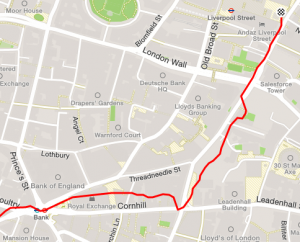Discussions around Garmin versus Suunto as training aids often seem to highlight very little other than folks saying “I’ve bought X and it’s the best” with very little to back up the statements. Having used devices from both manufacturers I consider myself to have a fairly unbiased view of the strengths and weaknesses of each and was asked recently which one I’d recommend, which led to a conversation about the particular needs of this runner and me thinking more broadly about who is best served by each device.
I’ll start with a bit of history about the watches I’ve used and the strengths and weaknesses of each.
My first running watch was a very basicPolar HRM that was little more than a stopwatch with heart rate display. It did the job but only because I was unaware of just what a watch could really do as a training aid. Buying a Garmin Forerunner 305 changed all that!
Since then I’ve become somewhat reliant on a watch as a training aid, navigational aid and motivator. This is generally good but can also be a problem if the watch lets you down and you are too dependent upon it.
Garmin Forerunner 305
The FR305 was my first proper training watch. I bought it in 2007 it revolutionised my training. At the time I was training for half marathons and training runs were transformed from what was often a chore into something much more challenging. For the first time I was able to have instant feedback on pace and distance and have a watch that could give alerts when outside the desired parameters.
Garmin Forerunner 310XT
I didn’t actually own this watch, I bought one for my wife as she was getting into triathlons but did on occasion use it if I needed more battery life. It was really a very small step up from the 305 with longer battery life and some triathlon features. It also used ANT to communicate with the PC rather than a wired connection but this was quite flakey. That combined with the fact that you still needed to plug it in to charge it meant that there really wasn’t that much benefit to being wireless. It certainly didn’t offer me any new features versus the 305 and had some bugs when displaying routes on the map screen (sometimes you saw nothing). I preferred the 305 apart from the fact that the battery wasn’t up to the duration required for the kinds of events I was now entering.
Suunto Ambit 2
Eventually the 305 started to become unreliable. It had stopped being waterproof a while back and now flooded if I was out in the rain. I think that eventually got to it so it needed replacing and the Ambit 2 looked to fit the bill.
The Suunto was a big change for me coming from Garmin but not terribly difficult to understand. The device itself was much smaller than the brick-like Garmins such that it could be worn as a regular day-to-day watch, albeit a somewhat bulky one. I was also attracted to the ability to create your own apps and very quickly knocked-up a run-walk app that gave me alerts such that I could stick to a 5:1 cycle in ultras; later on I added further alerts for eating and electrolytes.
I was however disappointed by a number of things. First off navigation. The “map” display was really very basic with just the planned route and your current location. Missing were a breadcrumb trail of where you’ve been, display of any saved locations nearby (only waypoints created as part of the route are shown) and no ability to zoom manually. There were also no alerts if you went off track. The Garmins had had all of these features so I had expected this or something similar. What this meant for me was that I could head off track without realising, look down at the watch and potentially not know which part of the visible track I should head for. In one race I managed to get lost in woods, lose my sense of direction and use the watch to navigate back to the route only to find this was a place I’d been a couple of miles earlier. The lack of zoom and breadcrumb trail was the problem here. Admittedly a paper map would have been a better option but I’d got used to the Garmin giving me enough to not really ever need a map.
The other big disappointment was the lack of training features. The “revolution” in my training mentioned above in part came about because I could plan my training months in advance with all kinds of different workouts with different pace goals. On the day I would just head out and ask the watch for today’s workout and get going. The Suunto seemed to have nothing. Intervals were ridiculously basic – just a single one where you set the durations but no goal pace or limits that could be set. Gone were the days where one day I’d run 8x400m and another day 4x1600m with different pace goals. I ended up just running mile intervals week in, week out and without the watch “moaning” that I was going too slow I just couldn’t keep focused enough to put out enough effort for a full mile. I definitely got slower in the year or two that I trained with the Suunto.
Another minor issue was the lack of alerts for low battery. There is a tiny indicator at the bottom of the screen but it was hard to distinguish if it was on 20% or 2%. In one race I let it get too low before connecting the charger and got an alert which gave a few seconds before switching off. Very annoying as once the charger was connected and the watch got going again the activity was logged as a brand new one. At least the old one was saved though.
You might get the impression that I didn’t like the Ambit but that’s not true. It was a rock-solid watch with did what it was designed to do very well it just didn’t quite live up to my expectations. At the time I was looking to buy it I also looked at the Garmin Fenix 2 but the reviews made it clear that it also wasn’t the watch for me as it wasn’t really designed as a running watch, it was more like a wrist-mounted Garmin outdoor device and so lacking all training features (or at least that’s how I understood the reviews).
Software Stability
The Ambit is rock-solid but the Suunto website (Movescount) had some extended periods where it was unavailable. This is a big deal with the Ambit as you can’t do route creation or change any of the configuration without using the web-based app.
Garmin Fenix 3
When the Fenix 3 was announced it sounded like exactly the watch I was after. Everything good found in the Ambit 2 plus all the features I’d been missing from the old Forerunners. The only problem was I couldn’t possibly justify spending all that money so soon. There was nothing wrong with the Ambit really, was there?
In the end I decided that I’d use the Fenix as a “carrot” to get me through my first hundred and set it as a reward if I could go sub-24. I succeeded and so ordered one within a couple of weeks of finishing the race. I wasn’t disappointed – this was a big step up: colour screen, smart phone integration, wireless connectivity (that worked), all the bells and whistles.
Returning to a Garmin device was great. Back to proper structured workouts with pace goals and navigation screens that really helped navigation. The colour screen helps here too as the display is really clear. There is also a ridiculous level of configurability of screens shown during workouts, even better these can be changed whilst out running so you can adapt the screens when you realise what you need rather than try and remember just what you wanted when you get home. This really came into it’s own during the night section of a race when I wanted a big single field display that was easy to read – easy, just did it then and there.
The Fenix is also smaller and lighter than the Ambit, not by much but enough that it’s more comfortable to run with for long periods), it also feels more comfortable as a daily watch so I now wear it all the time rather than just when out running.
Accuracy
There’s been a lot of noise in the forums about the Fenix 3’s accuracy. For general trail use it’s spot on, even under tree cover, however in the city surrounded by tall buildings it is quite a lot worse than all previous watches I’ve owned. This can be seen in the tracks from the 3 watches and shown here (taken years apart so not a scientific comparison but representative as this is a route I run frequently and day-on-day each watch performs much the same with very similar errors):
The Fenix 3 looks to be the worst of the lot here and the Ambit is the best. Fortunately for me I’m not too bothered about GPS accuracy in built-up areas and I don’t for example, see problems of this nature when running trail, even under heavy tree cover, so really this is a minor annoyance for me, the only real downside is that I end up with ridiculously fast stats for the final mile of my run to the office.
Navigation
Uploading routes to the Fenix 3 isn’t terribly easy. You can plan routes on the Garmin Connect site and send them to the watch but I prefer to use other sites for route creation which result in a GPX file that you then want to send to the watch. The watch also supports turn-by-turn navigation (much like you get from a car Sat Nav) although that requires files of a very specific format that need custom tools to create (Running Badger’s converter). In terms of getting a GPX onto the watch there are a number of approaches but the only one I’ve found to work reliably is to import the GPX into Garmin Training Center and then upload to the watch from there. A bit of a faff though. Garmin really need to allow GPX uploads for route creation in Garmin Connect just like you can in Suunto’s Movescount.
Software Stability
The Fenix 3 has had some pretty shoddy software updates over the last year. v4.0 of the firmware was really, really bad and resulted in the watch letting me down during the NDW100. I’m pleased to say that v6.5 and v6.8 have been very good so hopefully those days are behind us.
One big benefit of the Fenix 3 is that you can do pretty much everything on the watch, even reconfigure screens during a workout. You therefore aren’t reliant on Garmin Connect being available to work with the watch.
Conclusion
The Garmin is a more feature-rich watch but is not without its problems. It also requires a bit more technical ability to use all the features. For me it is the stand-out winner. I was recently asked by a runner which one to get, and after a long discussion about their requirements and how comfortable they were with technology in general in ended up recommending the Suunto so it really does depend on what the key features are for you.
Of course the comparison here isn’t really fair as I’m comparing Garmin’s latest offering with the previous Suunto one and should really be looking at the Ambit 3. The Ambit 3 does have smartphone integration but from what I’ve seen it has no real improvements in the navigation and training areas that I found so lacking.




